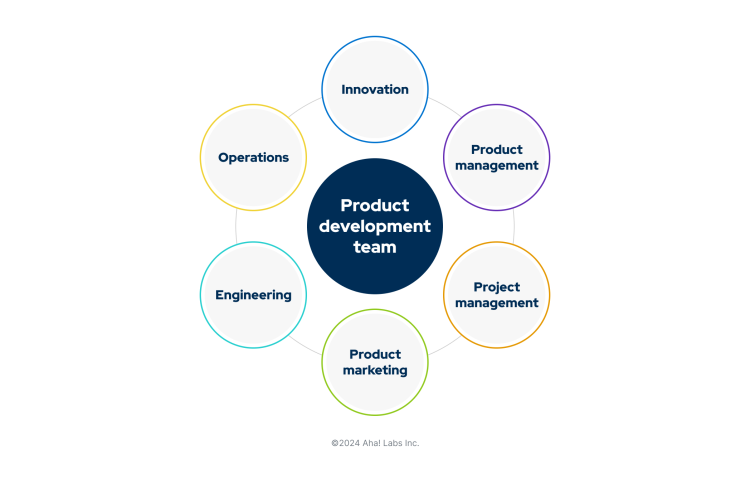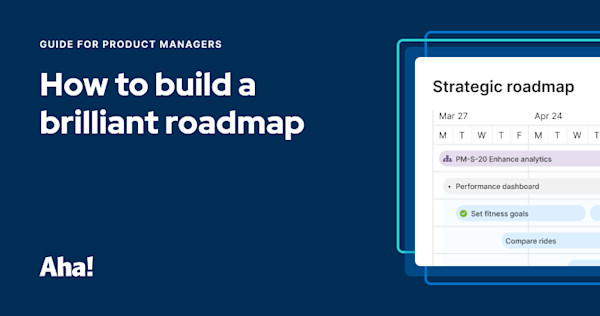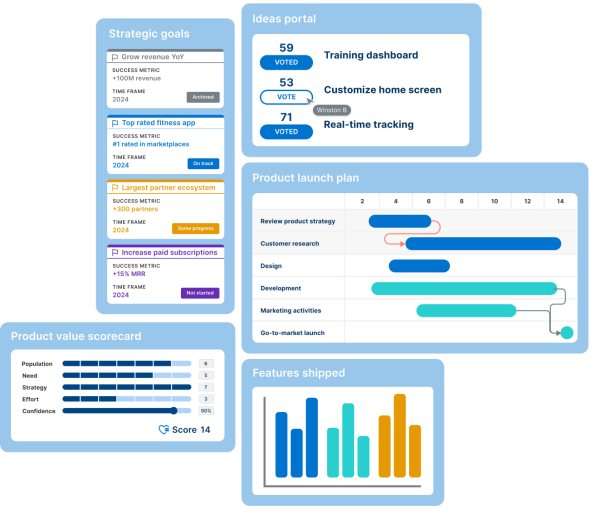What is product development?
An essential guide for product managers
Last updated: April 2025
Product development is the ongoing process of creating and improving products to deliver value to customers. It begins with strategy and discovery, moves through ideation to roadmapping and planning, and results in new or enhanced functionality that product teams build and launch into the market. The product development process continues as teams gather feedback to improve the offering over time.
Whether you are introducing a brand-new offering or improving an existing product, the product development process is about much more than "how" a product is built. It also involves the "why," "what," and "when" — encompassing cross-functional work from product management and engineering all the way to product marketing. Your goal is to work together to build, launch, and refine a product that customers love.
Streamline product development with Aha! software — sign up for a trial.
In this guide, you will learn the fundamentals of product development: everything that goes into shaping a product that drives meaningful impact and delivers lasting value.
What are the stages of product development?
No two organizations build products in exactly the same way. But there are standard stages that nearly all teams cycle through, from setting strategy to analyzing success. You typically complete one stage before moving to the next, but you can refine decisions and solutions throughout the entire product development process.

These are the 10 stages of the product development process:
Strategize: Define goals and initiatives.
Discover: Conduct customer interviews to uncover key product insights.
Capture: Streamline customer feedback and collect promising ideas.
Explore: Brainstorm and refine ideas on a whiteboard.
Plan: Prioritize ideas based on strategic goals, estimated product value, and team capacity.
Showcase: Share roadmaps and go-to-market plans with stakeholders.
Build: Deliver new functionality via agile development.
Document: Centralize product knowledge for internal teams and customers.
Launch: Bring those exciting new capabilities to market.
Analyze: Assess realized product value by tracking customer usage and love.
Related:
Which teams participate in product development?
As a product manager, you guide the product's success. You set product strategy, build the roadmap, and define product features. And you sit at the center of the cross-functional product team: folks from across the organization who contribute to delivering the product. This typically includes representatives from project management, product marketing, engineering, operations, and innovation.
Every organization defines its product development team differently, depending on its product and industry. But this group often made up of people actively involved in the stages of product development. This team also collaborates with other stakeholders who participate in the product's success as well — think customer success, sales, finance, and legal. Everyone in a product-led organization plays an important role in understanding customers and delivering a Complete Product Experience.

A product team typically includes people representing the following functions:
Product management | Product managers play a crucial role in the product development process, with work spanning from strategic objectives to tactical activities. You set product strategy, define what the product team will deliver and when, and communicate progress against the product roadmap. |
Project management | Project managers oversee specific projects within the broader product development process. They manage project timelines, budgets, and cross-functional dependencies. They work to ensure everything is completed on schedule and within scope. (Depending on the size of your organization, you might involve program managers as well.) |
Product marketing | Product marketers determine how to share the product's story. They craft positioning and messaging, research the competitive landscape, and create buyer personas. They also manage go-to-market campaigns, build awareness, and increase product usage. |
Engineering | Engineers are integral to the product development process. They are responsible for "how" the product is built — collaborating on features and user stories, estimating work, planning sprints, and releasing new functionality. |
Operations | The product operations team is responsible for product team efficiency — helping to improve internal workflows, promote best practices, manage product analytics, and administer the product team's tech stack. |
Innovation | Innovation teams strategize on new ways to approach problems the business and its customers face. They combine fresh product ideas with market analysis to propel product strategy and avoid stagnation. |
Related:
What are some common product development frameworks?
Because the product development process is so complex, many teams choose to follow proven frameworks to help guide their work. Some product development frameworks focus on specific stages or bodies of work, while others (such as The Aha! Framework for product development) provide guidance for the entire process.
The specifics will vary based on what you are actually building, but let's go over some common product development frameworks you might consider.
Early-stage product development frameworks
Imagine that your organization is just embarking on the product development process. There are a number of early-stage frameworks that you can follow to get started. Most of these approaches advocate understanding customer needs, market research, prototyping, and testing ideas before fully investing in product development. Here are a few well-known options:
Framework | Definition | Typical steps or components |
Design thinking | A framework for design and innovation. It includes cognitive, strategic, and functional processes for developing new concepts. |
|
Front-end innovation | A framework for the beginning stages of the product development process. It is used to scope out a product concept and determine whether or not to invest further time and resources in it. |
|
New product development (NPD) | The process of taking a product from concept to market availability. NPD can apply to developing a new product as well as improving an established product. |
|
Agile product development frameworks
Many product teams embrace an iterative approach to product development based on agile methodologies. They incorporate customer feedback early and often, release work incrementally, and welcome and expect change.
Agile product development frameworks help teams stay efficient as they build and ship work. Some of these methods have comprehensive steps and principles to follow, while others are more lightweight. Likewise, some have a strategic focus and others lean more tactical (or are even a balance of both). Here is a brief overview:
Framework | Definition |
A comprehensive, strategic approach that defines activities for each of the 10 stages of product development. It focuses on defining strategy, building roadmaps, and managing agile development work to deliver the most value to customers and the business. | |
An agile approach that focuses on cross-functional collaboration and delivering products in short iterative cycles. | |
A structured framework and set of guidelines for implementing agile and lean principles at an enterprise level, aligning multiple teams to work on large-scale initiatives. | |
An agile development methodology that helps teams work more efficiently by visualizing work, limiting work in progress, and maximizing flow. | |
An approach where work progresses through sequential phases, including planning, design, implementation, and testing. |

A visualization of how The Aha! Framework supports all 10 stages of product development.
Related:
How to create a product development plan
Product development represents many teams and types of work, typically spanning a lengthy timeline. So keep in mind that it will be unrealistic to make one plan for the entire process. (Plans often change, anyway.)
But we know it can be daunting to move forward without one at all. If you are embarking on a new product development process or rethinking your current approach, here is how you should start planning:
Set your product development strategy. Define the biggest pieces of your product strategy, like your product vision and mission. This will be the basis for any goals and initiatives as you move forward. You should also consider whether to follow any product development frameworks, then align with the team on your goals for the overall product development process.
Organize your product development team. Assemble the right people to drive the process forward. You might need to establish formal product teams from scratch or reconfigure the current team structure to better reflect your strategy.
Choose tools to support your product development process. Product development requires constant cross-team collaboration — work changes hands often. It is tough to pull this off when bouncing between several different tools, especially if they are not purposefully designed for product development. Consider using dedicated product development software to streamline your efforts.
Document and share your plans. The right information keeps people on track. As you start to define your approach to product development, capture key principles, roles, and processes in a central knowledge base the whole team can access. You might create a product team charter or even a strategic roadmap to visualize your plans.
It can also be valuable to learn from real examples. If you are curious, we documented all the activities the Aha! team completes at each stage of product development. This may help you understand the practical side of the product development process and plan your own approach.
We consider our team to be experts in product development. And while an introductory guide surely cannot capture all of the intricacies of this work, here are some best practices that we recommend thinking about as you chart your course:
Keep a clear focus on business and customer value.
Facilitate deep cross-functional alignment.
Promote a shared understanding of plans and priorities.
Enhance visibility and transparency throughout the process.
Remain focused on meeting real customer needs.
Track and measure value through each phase of development.
Invest in tools that support an agile approach.
Related:
Product innovation is integral to a company’s continued success. It comes down to creating value — for your customers and for your business. It sounds simple enough, but this is difficult work. An integrated product development suite is vital to staying aligned, tracking work, and transforming ideas from concept to launch.
FAQs about product development
The product development process provides structure and focus for everything product teams do. It helps you build what matters — from the moment you set product goals until you analyze the results of a launch. It also helps you solve real customer problems while aligning with business objectives. Without a clear process, product teams may waste time and resources on less impactful work.
There are 10 steps, or stages, in the product development process. The process begins with setting product strategy, moves through ideation, product roadmapping and planning, and results in delivering something new to customers. Each stage includes various activities. Some organizations might condense the number of steps, but understanding all 10 stages can bring the most clarity to the overall product development process.
The product development process is how you plan, build, and release new or improved functionality. The product lifecycle spans much longer — it encompasses how a product evolves from introduction to growth, maturity, and eventual decline. Typically, the product development process repeats many times over the course of a product's lifecycle.


